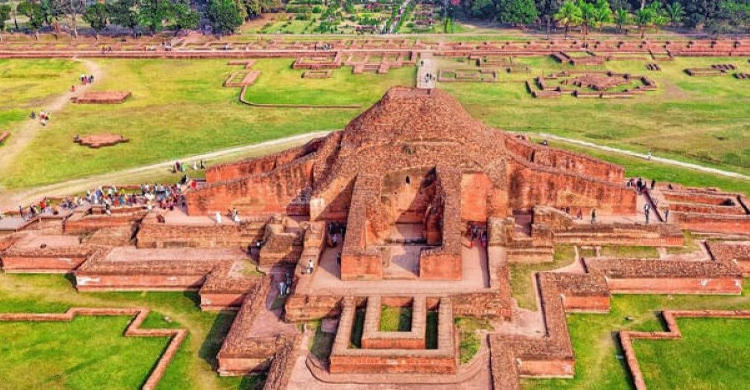Paharpur Buddhist Vihara attracts thousands daily, generates over Tk 1 cr annually


The Paharpur Buddhist Vihara, South Asia's oldest archaeological site and a UNESCO World Heritage Site since 1985, continues to draw large numbers of visitors every day, generating more than Tk one crore annually for the government.
Located in Badalgachhi Upazila of Naogaon district, this historic site welcomes both domestic and international tourists who admire its impressive architecture and sprawling grounds. Visitors have praised the site's beauty and the modernization efforts that have enhanced the overall experience.
The Vihara is well-equipped with visitor facilities, including a grand main entrance. On the south side of the entrance is a room exhibiting archaeological artifacts and books, while the north side houses the ticket counter, public restrooms, and a mosque. For visitor convenience, there are 10 rest shelters and several seating areas along the pathways, along with parking and a picnic spot. Security measures at the site have also been commended by guests.
Speaking to BSS, Fazlul Karim Arzu, Custodian of the Paharpur Museum, emphasized the significance of the Vihara, describing it as the largest Buddhist Vihara not only in Naogaon but across Asia. He also shared that new development plans are in progress to further enhance the site.
The museum on-site, established in 1993 with support from the Norwegian government under the supervision of the Bangladesh Department of Archaeology, displays a rich collection of artifacts. These include silver coins from the era of Caliph Harun al-Rashid, thousands of terracotta plaques, stone statues, copper plates, inscriptions, and traditional weights and measures.
Historically known as Somapura Vihara or "Chander Lokaloy" (Town of the Moon), the site once served as the capital of the Pala dynasty and operated as a major university for over 300 years. It was a renowned center for Buddhist learning and practice, attracting scholars and practitioners from China, Tibet, Myanmar, Malaysia, Indonesia, and the Indian subcontinent.
The vast monument was first uncovered in 1879 by Sir Alexander Cunningham. Comparable in size to India's Nalanda Mahavihara, the site covers 70.31 acres.
According to historians, Dharmapala, the second king of the Pala dynasty, constructed the Vihara in the late 8th century. The site was active primarily between 771-810 AD and around 812 AD.
Before excavation, it was locally known as Paharpur (meaning Gopal's Pyre), located in Paharpur Union. The remains visible today belong to the second phase-a Buddhist Mahavihara built over an earlier Jain Vihara.
Excavations took place initially between 1923 and 1934, followed by further phases from 1982 to 1990 (except during 1986-87).
The Vihara was designed around a roofless central courtyard and contained 117 rooms for monks. The main temple was approximately 400 feet long, 350 feet wide, and 70 feet high, surrounded by a 20-foot-wide enclosing wall.
Construction primarily used moulded baked bricks and clay, with large cut stone blocks used for features such as water channels, pillars, doorways, and footrests. The temple was built in a three-tiered, pyramidal shape based on a Greek cross layout.
The outer walls were unplastered but richly decorated with ornate brick carvings, including pyramid motifs, chains, checkerboards, twisted ropes, diamond shapes, and floral geometric patterns.
The foundation of the lower steps contained 63 stone statues, and rows of terracotta plaques decorated the walls below the cornice. These plaques depict a variety of scenes from folk life, animals, religious themes, and stories from classical texts like Panchatantra and Hitopadesha.
Scattered around the courtyard are numerous smaller structures, including administrative buildings, votive stupas, a dining hall (refectory), kitchen, and a well.
